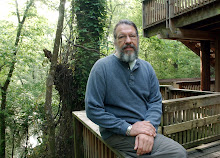Whooper Watchers: (L) Ezra Pound, (R) T.S. Eliot
(photo by Mark Manuel)
Not so very long ago, Whooping Cranes were common on our continent, ranging from New Jersey west to Utah, and from the Arctic coast southward to the central Mexican coast – Louisiana included. As late as 1899, famed Texas biologist Vernon Bailey characterized them as “common” in the prairies of Jeff Davis parish near Iowa, LA.
It is said that the advent of mechanized agriculture – and particularly the draining of the marshes and wet prairies – is what did the whoopers in. By 1941 only 15-20 birds remained continent-wide, including six birds in an isolated non-migratory colony just north of White Lake in southwestern Louisiana. By 1950, the last surviving member of the Louisiana colony was trapped and transported to the migratory colony that winters each year on the central Texas coast. Alas, shortly after its arrival it was killed by a coyote . . .
Whooping Cranes are about 5' tall, with 7.5' wingspans & weigh about 15lbs
(photo by Mark Manuel)
A Whooping Crane restoration program was initiated shortly thereafter. Today, after 60 years of work, around 400 whoopers exist in the wild, limited to one larger migratory colony that annually commutes between its Saskatchewan breeding grounds and wintering grounds in coastal Texas, as well as a small, introduced colony located in central Florida. An additional 150 individuals are kept in captive breeding programs in several locations in the U.S. and Canada.
Four Runaway Whoopers at the Cazan's Lake complex
Northeastern Evangeline parish; 28 May 2011
In mid-February of this year (2011) ten young Whooping Cranes were transported to White Lake (western Vermilion parish), the last known Louisiana location of the historical flock, in an effort to re-establish a non-migratory colony in Louisiana. Three months later, four of the ten whoopers had elected to relocate themselves about 65 miles northeast of the original reintroduction site at White Lake, to David Fontenot's rice farm in northeastern Evangeline parish.
David Fontenot, Mac Myers, Mark Manuel
Talkin' Whoopers
On May 26, a week after David had discovered the whoopers at his place, I received a call from old childhood buddy Mark Manuel. He had run into David somewhere, and David had told him the story. Knowing that I'd be interested. Mark called with an invitation to check out the birds at David's farm.
David farms the old “Cazan's Lake” complex, due east of and contiguous with Chicot State Park. Together, these two natural areas hold about 10,000 acres of wetlands and woodlands, much of it inaccessible to all but a few people. This area was a big part of my own stomping grounds back in the day. In fact, Cazan's Lake (actually an amalgamation of several different lakes and swamps surrounded by rice fields and bordered by Bayous Chicot and Cocodrie) once hosted a hunting/fishing club, of which I was a member in the 1960s.
Concerned that my camera might not be quite up to snuff, I invited long-time Louisiana birder Mac Myers along, as I knew his camera was better than mine. Fortunately, Mark brought his camera along as well, and between the three of us we came up with an acceptable – if not artistic – batch of pictures.
The weather was fine, the landscape gorgeous; and it was a real treat to not only see Whooping Cranes (for the first time in my life) but also to reconnect with David and Mark.
Fortunately for us, but unfortunately for them, the birds are not very wary, at times allowing us to get within 50 yards of them. We all wondered aloud what would become of these beautiful creatures once hunting season begins.
David did the right thing, immediately contacting Louisiana Department of Wildlife & Fisheries to tell them what he had found. Days later, two Whooping Crane Reintroduction Program specialists arrived to document the birds, assuring David that they would be back on a weekly basis to check on them.
What are you gonna do, you know? Birds have wings. And minds of their own. And whoopers have relatively ancient genetics – hardwired for who-knows-what? Continental drifting, would be one guess.
For now, these birds looked to be steadily foraging (we could not determine exactly what they were eating) and looked to be quite content.
So it's like my dad -- and favorite hunting/fishing partner -- used to say: “We shall see what we shall see . . .”






No comments:
Post a Comment